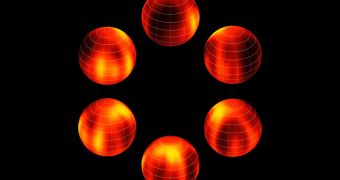An international team of astronomers recently used the Very Large Telescope (VLT), in Chile, to produce the first-ever map showing weather patterns present in the atmosphere of a brown dwarf.
The object in question is known as WISE J104915.57-531906.1B, and is thought to be the nearest brown dwarf to Earth. The object is also known as Luhman 16B, and it lies just 6 light-years away from Earth. By comparison, Proxima Centauri, the Sun's nearest stellar neighbor, lies 4 light-years away.
This study was conducted using the 4 primary and 4 secondary telescopes that make up the VLT. The installation is located at the Cerro Paranal Observatory, in Chile, and is operated by the European Southern Observatory (ESO). The VLT is one of the most capable optical telescopes in the world.
Brown dwarfs are objects that can best be described as failed stars. They are usually larger than the most massive gas giants, but are unable to sustain nuclear fusion reactions at their cores like even the smallest stars can. They also tend to be very cold, which makes them difficult to detect.
However, the tremendous capabilities of the VLT, combined with the fact that WISE J104915.57-531906.1B is located very close by, enabled astronomers from the Max Planck Institute for Astronomy, in Heidelberg, Germany, to observe light variations in the brown dwarf's atmosphere, the first observations of this kind ever conducted.
Details of the investigation were published in the January 30 issue of the top scientific journal Nature. The team reveals that the target brown dwarf is located in the southern constellation of Vela (The Sail).
“Previous observations suggested that brown dwarfs might have mottled surfaces, but now we can actually map them,” explains MPIA astronomer Ian Crossfield, who was the lead author of the new Nature paper.
“Soon, we will be able to watch cloud patterns form, evolve, and dissipate on this brown dwarf – eventually, exometeorologists may be able to predict whether a visitor to Luhman 16B could expect clear or cloudy skies,” he goes on to say.
Crossfield says that the recent observations were conducted using the CRyogenic InfraRed Echelle Spectrograph (CRIRES) adaptive optics instrument on the VLT Unit Telescope 1, called Antu or UT1. This experiment is sensitive to infrared wavelengths between 1 and 5 micrometers.
“Our brown dwarf map helps bring us one step closer to the goal of understanding weather patterns in other solar systems. From an early age I was brought up to appreciate the beauty and utility of maps. It's exciting that we're starting to map objects out beyond the Solar System!” the team leader concludes.

 14 DAY TRIAL //
14 DAY TRIAL //